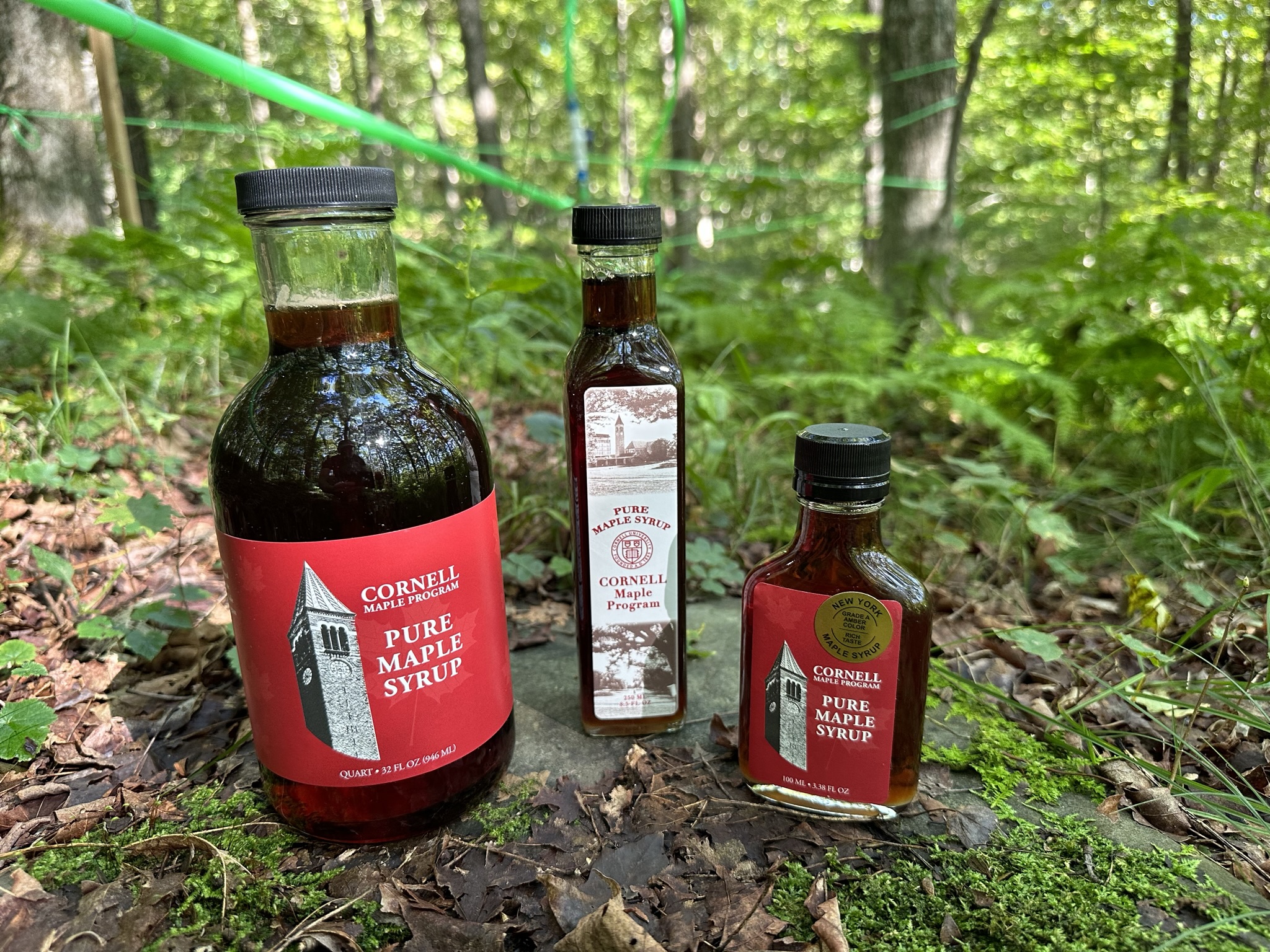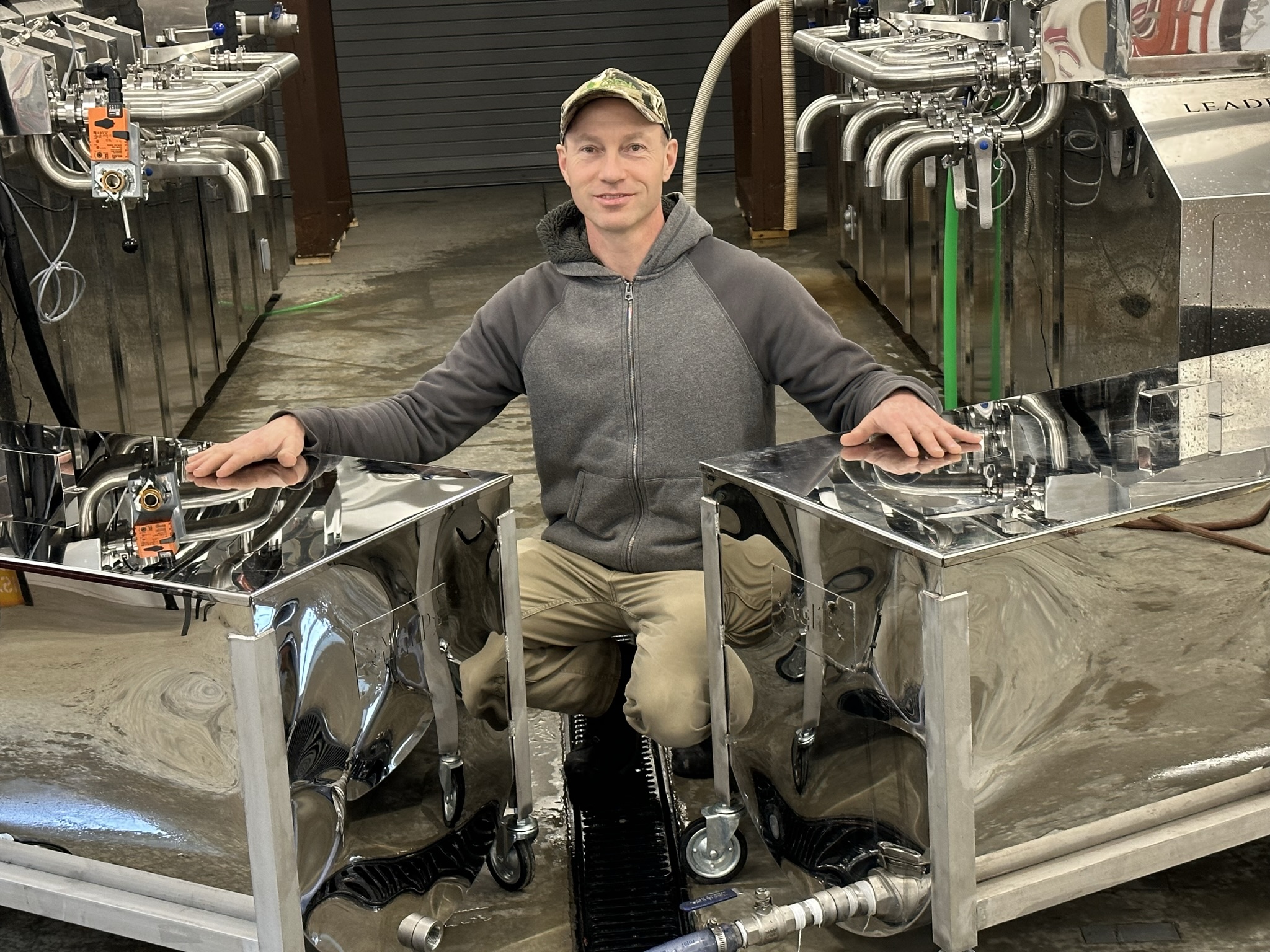New York’s maple specialist has a sweet gig
Aaron Wightman spends early spring days tap troubleshooting and syrup processing, but he thinks about climate change, too.
Marta Hill • August 3, 2025

Most of the syrup Aaron Wightman oversees is bought by Cornell University and sold in bookstores and served in dining halls. Every year, Wightman hopes to make about 2,000 gallons of syrup from the Arnot Forest. [Credit: Aaron Wightman]
During sugaring season, Aaron Wightman can’t seem to stay off Maple TV. That’s what he calls the phone app he relies on to monitor the forest he oversees near Cornell University.
Earlier this spring, the news was sweet. “Right now, it’s pouring in. It’s quite a sap run we’ve got going,” Wightman says when interviewed in March — peak time for maple sugar production.
The app lets him and the rest of his team at Cornell track virtually every part of the complex, vacuum-sealed network of tubes, taps and pumps that slurps up sap from more than 5,000 trees at Cornell’s Arnot Forest. The sap then heads to the university’s sugar house, where some sophisticated machinery transforms it into the sweet syrup that ends up on Ithaca breakfast tables.
In a typical year, Wightman hopes to produce about 2,000 gallons of finished syrup, though this year’s haul was only 920 gallons. Cornell buys most of the syrup and it is served in university cafeterias and sold in the bookstore.
Wightman’s days during sugar season start early, and he gets right into maple business. Alerts from Maple TV shape much of his day, but before he gets to those, he always spends time answering questions from maple growers all over New York.
“Hundreds, if not thousands, of people seem to somehow have my personal cell number,” he says. “I get texts at five, six in the morning, but if I’m up, I answer them.”
Wightman is the Statewide Maple Specialist for New York, which trails only Vermont in maple syrup production. That makes him the first call for Empire State sugarmakers if things seemingly go awry. Questions range widely, from growers concerned that their maples are budding too early (they usually aren’t) to equipment malfunctions like the lid of a reverse osmosis processing machine blowing off.
“I don’t always know the answers, but I have enough of a network that I can hook people up with equipment dealers or people that do know the answers,” Wightman says.
Some of those questions include worries about climate change, which is gradually altering the February and March cycles of near-freezing weather that get the sap flowing. Cornell is monitoring the changes with its Maple Climate Network.
“Climate change is a double-edged sword for maple,” Wightman says. The sugar harvested to make maple products is produced during the tree’s spring and summer growing season, so if the weather is too hot or the trees otherwise have a bad growing season, syrup production will fall. And if the weather doesn’t allow for overnight freezes and daytime thaws during sugar season, less sap will flow, which in turn means less syrup.
The changing climate doesn’t spell the end of maple syrup in the United States, but it may force some changes, especially in the warmest regions where sugar maples grow, says Jeremy Solin, a maple producer in Wisconsin who until recently held a position similar to Wightman’s in his state. “If you’re in the southern range of maples right now, that’s not a good place to be, I would say,” Solin says.
Wightman comes by his maple knowledge honestly — he grew up making syrup on his family’s farm in Allegany County.
“I went to college for physics. Got chewed up and spit out by the Cornell physics department,” he says. He went on to get his master’s in forestry and work as a forestry consultant. “When this chance to work at the Arnot Forest at Cornell and be the maple specialist came up, that was a dream job for me,” he says.
Wightman is now eight years into his dream job and loves how it combines his fascination with forests with a cultural experience he holds dear.
“My own esteem for Aaron grows each year. He’s a very forward-thinking researcher,” says Helen Thomas, the executive director of the New York State Maple Producers Association. “He’s not just answering people’s questions, he’s also thinking up the questions of, ‘What do we need to know?’ and planning research that goes along with that for the next 50 years.”
After assuaging maple producers’ fears every morning, Wightman turns to managing his own forest. Maple TV notifies Wightman and his team if there is an issue anywhere in the miles of tubing that collects the sap in the maple trunks and sends it to the syruping facility. The pressurized system allows the sap to flow continuously, instead of just relying on gravity.
“It’s pretty sophisticated,” Wightman says. “It monitors the vacuum level at the pump and looks for a differential between it and the woods,” which would indicate a leak or other issue.
When a leak or stoppage does come up — and Maple TV sends everyone a notification — Wightman, or one of the technicians on staff, heads out into the woods to fix it as soon as possible.
If all is well in the tubing network, Wightman can focus on the various research projects he helps to run in both of Cornell’s forests: the Arnot forest that Wightman oversees and the Uihlein Maple Research Forest 300 miles to the northeast near Lake Placid in the heart of the Adirondacks.
Wightman divides Cornell’s maple research into five basic buckets: sugar bush management, sap collection systems, equipment, food safety, and marketing and new product development. For example, this year, he’s running a project comparing two different tapping mechanisms, with the hope of preventing bacteria and yeast growing into the tap hole and stopping the flow of sap.
Inevitably, a lot of Wightman’s research focuses on climate questions because New York producers are concerned about the issue. “You would have to be supremely ignorant to not know that maple syrup production is heavily impacted by climate change because everything we do depends on your specific climate conditions,” Wightman says.
Even the tapping mechanism project has a climate tie: warmer spring temperatures can increase bacterial growth in the tubing.
On the food science side, Wightman is looking at the amino acid changes in late-season syrup in hopes of understanding how to remediate any flavor changes in late-season syrup.
Here, too, there’s a climate angle. What counts as late-season syrup is changing. The season has both shifted earlier and shortened over the years, Wightman says — people now are tapping as early as December, instead of starting in March like they used to.
“Now is probably the time to start experimenting,” Wightman says. “We have to be really proactive about thinking about earlier tapping dates … and just being prepared with the knowledge and experiment with it to see what works and what doesn’t in this warming climate.”
One possible way to make the syrup industry more resilient to climate change is by tapping other types of trees, not just sugar maples. Red maples are an appealing choice, Wightman says, because they are more well adapted to climate extremes and have similar sugar levels to sugar maples.
A lot of the yearly activity for Wightman is packed into just a few weeks in the spring. During sugaring season, he often stays at work well past midnight to process the sap collected during the day.
During a good sap run, the trees under Wightman’s watchful eye can produce two gallons of sap per tap in a 12-to-24-hour period. With 5,000 trees tapped this year, this means Wightman is using much of his 16,000 gallons of outdoor sap storage every day.
Sap flows out of maple trees because of the vacuum pressure inside the tree itself. The ideal weather for sap output includes lots of solid freezes overnight followed by warmer days. When the weather is cold, like it has been this winter, enzymes that convert stored starches into sugar are triggered, making the overall sap sweeter.
“A good sap run isn’t just volume of sap,” Wightman explains. “It’s a good volume of sap with high sugar content.”
But even particularly sweet sap is far from being pancake-ready syrup. It takes about 43 gallons of sap to make just one gallon of syrup — a process that used to be done by simply boiling the sap for hours on end, just like Wightman remembers from his family’s sugar house.
The sugar house at Cornell utilizes a much more complex process. It’s full of large pieces of equipment, including evaporators, blowers, reverse osmosis machines and high-pressure turbine pumps.
“It’s hot, it’s noisy, but it’s highly productive. We can make a lot of syrup,” Wightman says. “We can make more in a day here than we made in the whole season in my family’s sugar bush.”
The sap first gets deposited into large outdoor vessels for temporary storage. Then it gets pulled into the building and goes through the reverse osmosis machines, which remove about 80% of the excess water. Then the sap goes to the evaporators to start boiling. The evaporators turn sap into syrup by getting rid of the last of the excess water. Syrup then flows out of the evaporator and is filtered and sealed in 40-gallon drums.

Aaron Wightman poses by the evaporators in Cornell University’s sugar house. The evaporators and reverse osmosis are named after characters in the original “Top Gun” movie — Jester, Goose and Maverick. [Credit: Aaron Wightman]
“Some of those nights, I don’t have a single chance to sit down. It’s like six to 10 hours straight on my feet,” he says. “It’s really a two-to-three-person job, but the way things work at our lab, it’s easier if I just do a lot of that at night by myself.”
This sugar house looks almost nothing like the one Wightman grew up in, long before the days of Maple TV apps and fancy machinery. “I spent a lot of time with my family in the sugar house, having conversations, playing cards, drinking cheap beer, which is a fun experience,” Wightman recalls.
Now, the sound of crackling fire and bubbling sap has been replaced with the noise of machinery so loud that the team has to wear ear protection. “It sounds like a jet engine,” he says.
But even if the scale of production is much bigger than what Wightman experienced as a child, the experience still takes him back to sugaring with his dad and grandfather.
“So many people fall in love with sugaring once they’ve experienced it,” he says. “It stimulates all the senses. The sugar house smells like maple syrup. There’s steam in the air.”
Sounds pretty sweet, doesn’t it?